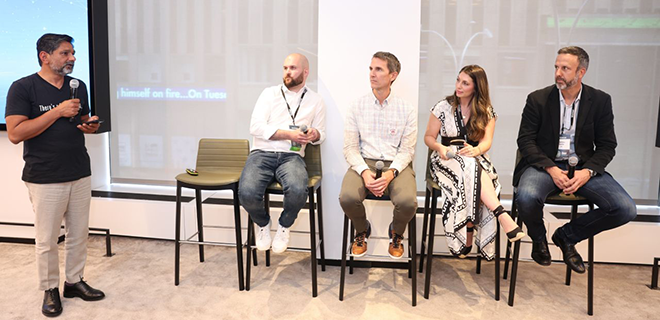
From Privacy Sandbox complaints to Trusted Server buzz, publishers have long had a love/hate relationship with the IAB Tech Lab. But did something shift last week?
Photo credit: IAB Tech Lab
“You got to give the people, now/ Give the people what they want” — The O’Jays
Look, I know the IAB Tech Lab has been a thorn in your side. You’ve raised your hand in working groups, waited on specs that stalled, and wondered—was any of this really built with publishers in mind?
You’re not alone.
But last week at the IAB Tech Lab Summit, it seemed like something else was in the air—something more collaborative, dare I say, more hopeful.
A Shift in the Air
Maybe it’s because for the first time in a long time, the Tech Lab wasn’t just handing down the gospel of specs. They were listening, opening up the lab coat to show the gears—Trusted Server, CAPIs, Containerization—and asking publishers to get in the mix.
And what do the publishers need? They need control. Signal. Infrastructure that actually works for them.

Not Just Another Spec Drop
When I spoke with Anthony Katsur, CEO of the IAB Tech Lab, back at IAB ALM in January, he told me that the Tech Lab needed to evolve beyond specifications into real tools. That it wasn’t enough to publish standards.
Publishers need usable frameworks, he said. That’s where Ad Creative ID Framework (ACIF) and Trusted Server come in.
Maybe last week didn’t deliver the final blueprint, but the gears were definitely turning. That evolution was finally taking shape.
Hope Floats, Skepticism Lingers
But don’t get it twisted—it wasn’t all love. Trusted Server may promise more publisher control, but some still see it as a complicated framework that’s hard to implement, costly to run, and maybe just another layer of obfuscation.
So yeah, hope floated, but skepticism sat in the back row, arms crossed.
During a Trusted Server workshop, someone asked whether Trusted Server and containerization (a secure environment that gives publishers more control over their ad tech stack) could eventually converge. The room paused.
“We’re not talking about that yet,” Katsur said. “But two years from now, when both initiatives are mature and hopefully adopted, then yes, there’s a very strong connection.”
That’s the line we’re still walking. Hopeful, but not yet concrete. Transparent, but still a bit fuzzy. If publishers are going to put their trust in the server, they’ll need more than just a spec. They’ll need the power to shape what comes next.
But trust doesn’t come easily. Not when the specs are still evolving and the infrastructure ain’t cheap.
What the Tech Lab Is Building
When we talked in January, Katsur told me that Tech Lab couldn’t just be a spec factory anymore. It had to become the connective tissue that lets publishers plug in, experiment, and build for the future.
Across the Summit, we heard that clear shift in tone. For instance, Trusted Server has evolved beyond a white paper into testable code and a real-world pilot program.
Rewiring the Plumbing, Reclaiming the Power
The framework moves key ad tech functions from the browser to a secure, server-side environment controlled by publishers. That means fewer rogue tags dragging down the page, tighter control over data flow, and a chance to bypass ad blockers.
But it also means building new infrastructure, wrestling with technical complexity, and navigating a steep learning curve. As one speaker said, this isn’t just about privacy compliance—it’s about rewiring the web’s plumbing so publishers finally control the valve.
As Katsur told me back in January, the goal is to give publishers more optionality—not everyone will build the same way, but they should have a real say in what gets built.
Publishers on the Mic
Stephanie Mazzamaro, Head of Programmatic, Addressability, and Ops at The Arena Group, wasn’t just in the room—she was on the mic at the Trusted Server Workshop panel.
After the event, she called Trusted Server “a groundbreaking shift in how publishers manage advertising in a privacy-first, post-cookie world,” emphasizing its ability to eliminate reliance on third-party browser-based code, improve page performance, and future-proof identity, fraud, and measurement.
“This work isn’t just about safeguarding future monetization,” she wrote on LinkedIn. “It’s about reclaiming control for the advertising ecosystem.”
And Then There Were CAPIs
Do we need one Conversion API to rule them all?
If Trusted Server is about rewiring the infrastructure, CAPIs are about feeding the machine with cleaner, smarter signals. Right now, every platform has its own version. Meta, Google, Amazon—they all want your data in, but good luck getting value back out.
Standardizing CAPIs will mean publishers and advertisers aren’t stuck decoding three different specs to understand what drove a conversion.
One API to Rule Them All?
“When we talked to marketers about building a CTV conversion API, their biggest ask was: give us flexibility to use our own measurement and identity providers,” said Ryan McConville, EVP & Chief Product Officer of Advertising Platforms & Operations at NBCUniversal.
That’s why the IAB Tech Lab is driving standardization. Why should only walled gardens benefit? Isn’t it time the open web does too?
Sure, the IAB Tech Lab’s CAPI won’t solve everything. But if it works, it could help publishers reclaim signal fidelity without having to bend to every platform’s bespoke rules.
Grab Your Seat at the Table in Nashville
At the AdMonsters Sell Side Summit, August 17-19 in Nashville, we’ll have Katsur with Jason White, Chief Product and Technology Officer from The Arena Group. They’ll be diving deeper into what collaboration looks like when the sell side isn’t just responding to specs—they’re writing the playbook.
See you in Nashville,
Lynne